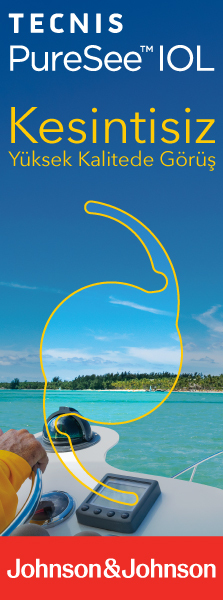2Doç. Dr., Abant İzzet Baysal Tıp Fakültesi, Göz A.B.D, Bolu, Türkiye
3Uz. Dr., Malatya Eğitim ve Araştırma Hastanesi, Göz Kliniği, Malatya, Türkiye
4Doç. Dr., Malatya Eğitim ve Araştırma Hastanesi, Nefroloji Kliniği, Malatya, Türkiye Purpose: The aim of this study was to evaluate changes in corneal biomechanical properties following hemodialysis using an ocular response analyzer (ORA) in non-diabetic end stage renal disease
Materials and Methods: We included one eye of 50 non-diabetic chronic renal failure patients (25 females and 25 males) with a mean age of 56.94 ± 9.95 years (range 36-80 years) in this cross-sectional study. Corneal compensated intraocular pressure (IOPcc), corneal hysteresis (CH) and the corneal resistance factor (CRF) were measured for included the eye of each participant using an ORA before and after hemodialysis. Central corneal thickness (CCT), blood pressure, plasma osmolality and plasma colloid osmotic pressure were also measured before and after the hemodialysis session. A paired samples t-test and Pearson?s correlation analysis were carried out for statistical analysis.
Results: The mean CCT, IOPcc, CH and CRF of the patients before hemodialysis were 550.20±19.64 ?m, 16.84±3.20 mmHg, 10.68±2.41 mmHg and 11.36±2.50 mmHg, respectively. The mean CCT, IOPcc, CH and CRF of the patients after hemodialysis were 547.30±19.83 ?m, 15.61±2.77 mmHg, 11.38±2.91 mmHg and 11.37±2.96 mmHg, respectively. The mean plasma osmolality, plasma colloid oncotic pressure and mean arterial pressure (MAP) of the patients before hemodialysis were 309.12±9.10 mOsm/L, 23.86±1.49 mmHg and 99.74±12.84 mmHg, respectively. The mean plasma osmolality, plasma colloid oncotic pressure and mean arterial pressure (MAP) of the patients after hemodialysis were 293.74±8.82 mOsm/L, 28.72±2.19 mmHg and 87.53±10.98 mmHg, respectively. Signifi cant changes occurred in IOPcc, CH, mean arterial pressure, serum osmolality and plasma colloid oncotic pressure (p values of 0.006, 0.036, <0.001, <0.001 and <0.001, respectively). There was no signifi cant difference in the CRF or CCT values before and after hemodialysis (p values of 0.980 and 0.084, respectively). There were signifi cant moderate correlations between differences in IOPcc and CH (r=-0.369, p=0.008) and MAP and CH (r=0.355, p=0.011).
Conclusion: Hemodialysis did not alter CCT and CRF but caused a signifi cant IOP decrease and CH increase in non-diabetic chronic renal failure patients that need be taken into account during the evaluation of IOP in hemodialysis patients.
Keywords : Corneal hysteresis, Corneal resistance factor, Hemodialysis, Intraocular pressure, Ocular response analyzer




